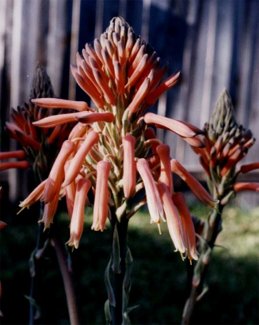Aloe
by Valerie (August 25, 2000)

Almost everyone has kept the popular Aloe vera as a houseplant at one time or another. Its easy care, medicinal properties and exotic look all contribute to making it a favorite. Although the small Aloe vera is very susceptible to freezing temperatures, there are other, more robust species that can withstand a light freeze. When we started a succulent garden in an especially dry area of our yard, we looked for bargain plants at local nurseries, and a medium sized aloe (Aloe sp.) in a 1-gal. pot for just a couple of dollars certainly qualified. We thought it might not make it through the first winter, but by covering it with a small sheet, we were able to extend its life for another summer season as it suffered only a little damage on the tips of its leaves. That was over 10 years ago. By the end of the next summer, the medium sized aloe had become a very large plant and bloomed with a 5-foot tall stem. I've tried to identify its species, but, because so many look similar, I have been unsuccessful. At least it is easy to tell in which genus it belongs. 
By about the second or third year, our aloe began to offshoot, with the new plants crowding close to the original and not growing quite as big as that first one. They bloom several times during the spring, with early blossoming stems being about 5 feet tall, but subsequent ones are only around 3 feet. As the buds start to protrude from the base, they look like snake heads on gently curving necks. The clustered flowers are a pleasing coral color, but don't seem to attract very many insects and have never produced seeds. The aloe patch has grown so large that it now requires a king-size sheet for protection on freezing nights. |
 Aloes are from Africa, and most seem to come from the southern part. They vary quite a bit in size and form, from tiny plants to tree sized. Some have smooth leaves while others are bumpy or spiny. The flowers are usually borne on a long stem and are generally yellow to red and tubular. The medicinal attributes of the liquid from the leaves of the Aloe vera is well-known. It works on burns, cuts and bruises. We have never tried using part of this large plant, so we don't know if it works the same way.
Aloes are from Africa, and most seem to come from the southern part. They vary quite a bit in size and form, from tiny plants to tree sized. Some have smooth leaves while others are bumpy or spiny. The flowers are usually borne on a long stem and are generally yellow to red and tubular. The medicinal attributes of the liquid from the leaves of the Aloe vera is well-known. It works on burns, cuts and bruises. We have never tried using part of this large plant, so we don't know if it works the same way.